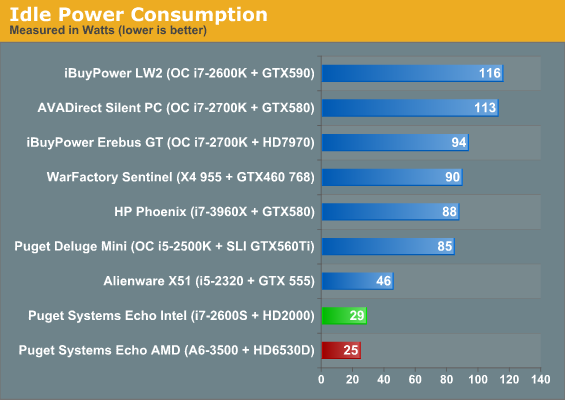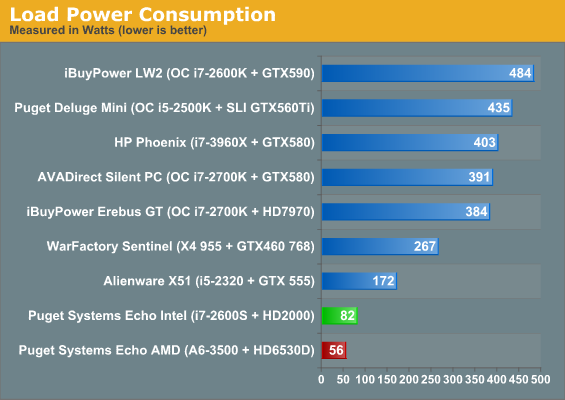Puget Systems Echo: Intel and AMD Showdown at 65 Watts
by Dustin Sklavos on March 21, 2012 2:35 AM EST- Posted in
- Systems
- AMD
- Intel
- Mini ITX
- Sandy Bridge
- Llano
- boutique
- Mini-Tower
Build Quality and Part Selection
Given the small nature of the Antec ISK-110 enclosures Puget Systems employs for their Echo I systems, it's not going to be much of a surprise that there's really only so much they can do to make build quality stand out. For what it's worth, the systems are put together as well as one can expect. Both use stock coolers from AMD and Intel, but given the low TDPs of the two processors (as well as the cramped confines of the enclosure) these coolers are never given much of a workout. Cabling is routed as well as can be expected, and Puget Systems filled both of the 2.5" drive bays. These systems really are packed to the gills.
.jpg)
This is a good time to bring up one of the ways Puget Systems distinguishes themselves from other boutiques, though. If you opt to configure a system on their site, you're going to find the number of available components substantially lower than you will from any other boutique. This has to do with their validation procedures; Puget is extremely picky about the parts they include in the desktops they ship and while I'd like to see this confidence reflected in a longer warranty than just one year, I've seen enough of their data (and their customer feedback) to corroborate their claims. It's the reason you only see Intel SSDs in their systems, for example.
It's also part of the reason why our AMD system is fighting a bit of an unfair fight, a point we brought up with Puget Systems and one they recognized. It's well known that Llano will use all the memory bandwidth it can get its hands on, while Sandy Bridge is much less sensitive. Puget hasn't qualified any 8GB DDR3-1600 DIMMs for deployment in any of their builds, and so they erred on memory capacity instead of speed. In conversations via e-mail, they even admitted this was probably a mistake in this instance. The problem is that they also don't offer any 2GB or 4GB DDR3-1600 DIMMs for the AMD-based system, either, when they do have 4GB DDR3-1600 DIMMs qualified for other builds.
As an aside, I did contact Puget Systems and ask why their parts warranty period was so limited compared to other boutiques, and their rationale is actually a fairly sound one: there's just no guarantee that the replacement parts will continue to be available for three years, given how fast hardware turns over in this industry. They don't feel a standard three year warranty is something they can in good conscience live up to, and so the three year warranty upgrade they offer is actually in place to cover the costs of offering brand new kit to replace defunct hardware should the need arise.
Heat and Noise
While I wasn't expecting too much in the way of thermal issues even with the stock cooling, I felt like noise could've gone either way when I pulled the two Echo systems out of their boxes. The side panel above the motherboard is completely ventilated, allowing fresh air to circulate inside the enclosure. That's great for cooling, but does absolutely nothing to muffle noise.
Thankfully, the circulating cool air does wonders to keep either heatsink's fan from having to work particularly hard. Neither system is actually audible while running unless you put your ear up to the open side; any kind of ambient noise in the room will muffle them. The result is that both systems never see temperatures above the low 60C on the cores, and noise is essentially a non-issue unless you're looking for a "silent" system.
Power Consumption
Most of the test results up to this point have been fairly predictable, but power consumption was a big surprise and a pretty stunning upset. Rather than build you up to it, I'll just show you.


At both idle and load, the AMD-based system beats the Intel-based one. Look at the load numbers in particular; the A6-3500 is able to beat the Intel Core i7-2600S by nearly thirty watts. I expected both to be frugal, but the A6-3500 is actually performing well under its rated wattage.


_thumb.jpg)
_thumb.jpg)
_thumb.jpg)
_thumb.jpg)
_thumb.jpg)
_thumb.jpg)








62 Comments
View All Comments
Spunjji - Friday, March 23, 2012 - link
This is addressed very well in the article, particularly in the conclusions. The editorial is nicely balanced if you took the time to read it.Yes, it stinks that people will look at the graphs in this and nothing else, but that's people for you and it's AMD's responsibility to combat that.
trane - Wednesday, March 21, 2012 - link
Since you have brought up video editing and gaming as the two usage scenarios, I would like to contest that Llano would do the former much slower than SNB. The GPU is not just for gaming, but GPGPU as well. Quite a few editing software today are starting to be heavily OpenCL GPU accelerated - including Sony Vegas and Cyberlink Powerdirector. I would have also mentioned Premiere Pro but it is CUDA only for now, should be OpenCL in the near future. Perhaps you should add a Sony Vegas Pro benchmark to your suite, Sony already have a standard benchmark project available (http://www.sonycreativesoftware.com/vegaspro/gpuac... and GPUs bring massive gains over CPU-only.Just a suggestion, as Llano's GPGPU capabilities almost always goes unnoticed, and unfairly so. Yes, not many applications are heavily GPU accelerated today, but video editing is certainly one of them.
It's a pity the A8-3800 isn't available, that would have been pretty great, and much faster than A6-3500 for a small price.
trane - Wednesday, March 21, 2012 - link
Here's a link to the benchmark project: www.sonycreativesoftware.com/vegaspro/gpuaccelerationDustin Sklavos - Wednesday, March 21, 2012 - link
The problem is that GPGPU and dedicated hardware encoding still, to my knowledge, have issues with end quality. If you're just transcoding for the internet or for yourself, they're probably fine, but CPU-only encoding remains the gold standard.That said, Premiere CS5.5 benefits tremendously from CUDA, but not entirely on the encoding side. Mercury Playback Engine still produces reference quality video, but CUDA accelerates decoding and effects layering on the timeline by a substantial degree, in some cases meaning the difference between editing in realtime and not.
GPGPU has promise but that promise is, presently, nascent on the desktop.
trane - Wednesday, March 21, 2012 - link
Do note that I am not referring to encoding! On Vegas Pro the entire video processing pipeline is heavily GPU accelerated. Right from decoding to colour space transforms to scaling to transitions/motion graphics to nearly all video effects - nearly everything is GPU accelerated - even before we hit the encoding stage. Much more extensive than Premiere Pro. Do give the benchmark project a try, you might be surprised how far GPGPU has come.silverblue - Thursday, March 22, 2012 - link
The i7-2600S sports QuickSync, so if the software supports it, it may not actually be a victory for AMD on this one.hypercube33 - Wednesday, March 21, 2012 - link
This is bull. As posted by sabot they have plenty of higher powered APU's available up to the newer A8-3800.This is like cutting off the arms of your opponent and then saying he didnt even throw a punch. I am not saying AMD is better, but this review is skewed so badly that its not even close to worth publishing.
weiran - Wednesday, March 21, 2012 - link
Yes AMD have a higher power CPU in the A8-3800. But available?I'm in the UK so the availability is probably even worse than the US, but I've been unable to find any stock of the A8-3800. The only place you can get one seems to be in pre-built HP desktops.
silverblue - Thursday, March 22, 2012 - link
Not to mention the significantly higher power consumption of a quad core CPU at 2.9GHz with much more powerful graphics. Sure, the 38xx series would be preferable, if only you could actually grab hold of them.The 3870K is available on CCL for £103, but the A6-3500 is a mere £55 from the same site. The only available models available on that site are the A4-3300, A4-3400, A6-3500, A6-3670K and A8-3870K - there is no sign of the 3800 or 3820.
djfourmoney - Thursday, April 12, 2012 - link
Its not just you, all the major e-tailers don't carry the A8-3800 in North America. The B&M's don't either (Micro Center and Fry's). That's why I got the A6-3500 and called it a day.An A4-3400 is plenty for HTPC use, does 29/59 and 3D without issues. When you start using 3rd party stuff like MadVR, you may have a few problems with interlaced content as found in Rene's testing on AVS forums.
The Triple Core is the best case scenario of price and performance. It will do what my current system does, only faster (current rig is 5000+ BE) and that's plenty for me.
MB, APU, SSD and Memory all for under $200